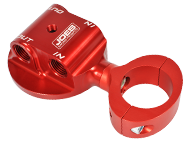Engines are expensive. Helping them last is important for every race team and finding extra horsepower is always a gift that keeps on giving. For horsepower and longevity, the oil system pumps black gold through the veins of your car while facing extremely demanding conditions. Dry sump pumps are the heart of many race engines and understanding a few basics will allow the heart of your car to extend the life of your engine while maximizing power.
AC Nutter
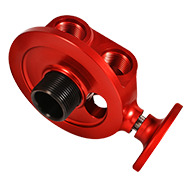 AC Nutter is an engine builder that builds high horsepower engines that have won numerous championships. AC has earned his reputation as a top builder through hard work and self learned creativity. Nutter engines include many ideas developed by AC through his years of hands on experience with top race teams. To support his Nutter engines, AC felt he could help his teams by designing and manufacturing his own dry sump pumps. The combination of being an engine builder and a pump manufacture gives him a unique perspective in understanding how to feed engines with oil properly.
AC Nutter is an engine builder that builds high horsepower engines that have won numerous championships. AC has earned his reputation as a top builder through hard work and self learned creativity. Nutter engines include many ideas developed by AC through his years of hands on experience with top race teams. To support his Nutter engines, AC felt he could help his teams by designing and manufacturing his own dry sump pumps. The combination of being an engine builder and a pump manufacture gives him a unique perspective in understanding how to feed engines with oil properly.
What are your thoughts on a dry sump venting system?
Nutter:
With a dry sump, the vent system must be designed to allow the engine to breath. A proper vent system prevents leaks and keeps precious oil in the car. Too often, tracks are oiled down due to venting system problems. With a three stage pump, it is a good idea to vent the engine valve covers along with the oil tank. You can use breathers on the valve covers or run a line from the valve cover to the tank and use the same vent for both the engine and the dry sump tank. I agree with AC and from my experience vent systems experience less trouble when you run a #12 line from the valve cover back to the tank and let the system breath with a vent back at the dry sump tank.
Valve Cover Breather
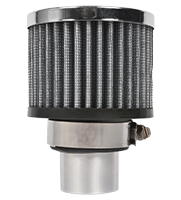 If you need to vent your engine at the valve cover, a breather kit can easily be welded at a location that allows teams to install the engine without impacting chassis bars.
If you need to vent your engine at the valve cover, a breather kit can easily be welded at a location that allows teams to install the engine without impacting chassis bars.
Nutter:
With a 4 stage dry sump pump, only the tank needs to be vented due to the added vacuum created by the additional stage. Utilizing a small baffled breather tank, with a vent on the top, nearly eliminates venting issues. Be sure to mount the breather tank as high as possible and as far to the left as you can. Connect the dry sump tank to your breather with quality hose. G force will help force oil that collects in the vent tank back down into the dry sump tank. With the breather tank mounted high, there is enough line length to allow gravity to keep the line clear so air can pass through easily. Be sure to avoid any droops in the vent hose to prevent oil from pooling in a low spot. Pooled up oil in a line can prevent the block the vent creating an oil mess that can potentially take you out of a race.
Oil Filter Cutter
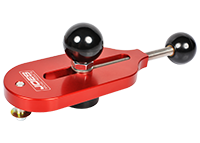 A good Oil Filter Cutter allows you to quickly cut open paper style filters. A quick inspection allows teams to find particles and debris that may indicate a serious engine problem. Paper filters are excellent at filtering out fine particles and are often used in conjunction with cleanable mesh style filters.
A good Oil Filter Cutter allows you to quickly cut open paper style filters. A quick inspection allows teams to find particles and debris that may indicate a serious engine problem. Paper filters are excellent at filtering out fine particles and are often used in conjunction with cleanable mesh style filters.
With a dry sump – what do you recommend for line sizes?
Nutter:
The line size question is a big one with many variables and lots of different answers. The most common system would be #12 lines from the pan to the pump. #12 is used to feed oil to the engine with a #16 line to provide a free flow of oil to the tank. Often, I think a #10 line from the pan to the pump is a better way as it provides more overall vacuum and improved performance.
How many stages do you need in a dry sump pump?
Nutter:
My first answer is to let your engine builder decide. Most engines that require a dry sump are in the high end category and your engine builder will understand all the variables that apply to your type of racing. Rules come into play as well and an experienced engine builder can design a dry sump package that meets the needs or your rules, race series and budget. On the surface, this seems like an easy question but there is much to consider and your engine builder will have a philosophy that creates an oiling system that meets the needs of your engine package and series requirements.
Three Stage Pump
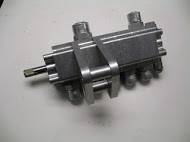 A three stage pump supplies ample oil to the engine. A four stage pump creates more vacuum. The added vacuum moves oil away from the rotating crankshaft assembly, producing more horsepower.
A three stage pump supplies ample oil to the engine. A four stage pump creates more vacuum. The added vacuum moves oil away from the rotating crankshaft assembly, producing more horsepower.
For a general answer, a three stage dry sump system works as well as a four stage system when it comes to prolonging engine life. 3 stages are plenty adequate to provide a steady supply of fresh oil to the engine. 3 stages obviously saves cost over additional stages as the pump cost is less and the car plumbing is simplified. Your team saves the work and the expense of added lines and AN fittings – those things add up in the cost column.
However, four or more stages will create more horsepower. 3 stages supply oil to your engine just fine – the added stages create vacuum in the oil pan and crank case area. Vacuum causes the oil to lie down in the pan to be efficiently picked up by the dry sump pump scavenging system. With the excess oil pulled down in the pan, oil is not picked up by the rotating crank and rods that spin at high RPM. Reducing the amount of oil that gets wrapped around the rotating assembly, results in horsepower gains. The engine can simply spin more freely.
Oil splashing around the pan and onto the rotating assembly robs horsepower. A fourth dry sump stage creates vacuum and reduces the amount of oil that splashes around inside your engine allowing the rotating assembly to rotate freely. Oil is thick and viscous. If the crank assembly has to beat its way through a pig pool of oil it will have to work harder. The beating action reduces oil life and can cause unwanted foaming. Basically, it is easier to walk down the street than it is to walk neck deep in a swimming pool. By removing oil from the pan, by utilizing vacuum created by the dry sump pump, you will find gains in horsepower. In our testing, we have found as much as 12 additional horsepower with a 4 stage dry sump pump as the rotating assembly can spin without having to fight through a pool of oil in the bottom of the pan.
Creating 8 to 12 inches of vacuum is all that is required to keep the rotating assembly free of excess oil. If your engine runs low tension oil rings you might need 18 inches of vacuum, or more, to keep oil away from the rotating assembly. Your engine builder can assist in making decisions. Something as simple as changing oil ring tension has an effect on the dry sump pump system and the vacuum needs are completely different depending on the ring design you run. Customers will experience less engine trouble if they recognize that a high performance engine is a package and even small changes can be interrelated – one thing affects another and each change needs to be thought completely through.
What do you consider in a dry sump system?
Nutter:
When using dry sump pumps you need to consider the entire oil system. Just a few considerations are dry sump reserve tank size, vent tank type and size, number of stages needed, plumbing line sizes and more. Pan design is a very important element. When it comes to oil pan designs, you want to use a pan that is as wide and deep as possible.
Dry Sump Breather Tank
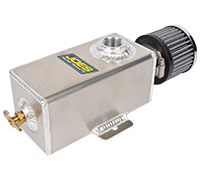 A Dry Sump Breather Tank should be mounted high so oil can easily flow back to the tank. Lines should be routed free of droops so oil can’;t pool up and plug the venting system. This tank has a drain valve in the bottom so teams can verify that oil is not backing up in the oil system.
A Dry Sump Breather Tank should be mounted high so oil can easily flow back to the tank. Lines should be routed free of droops so oil can’;t pool up and plug the venting system. This tank has a drain valve in the bottom so teams can verify that oil is not backing up in the oil system.
Scavenge filtering and engine oil filters must be considered. I prefer oil filters without a bypass. The dry sump pump mounting and drive system varies from car to car and choices must be made that ensure that your dry sump pump is mounted securely with a drive system that will perform 100% of the time. Nearly every dry sump pump on the market is of good quality. I recommend that teams purchase what they can afford and design an overall system that mates up with their rules while placing emphasis on their individual budget. It does little good to install a system that you can’t afford to maintain. In general, the more you spend on a dry sump pump then the more expensive it is going to be to maintain.
What to your recommend for oil filtering?
Nutter:
Paper filters clean oil just fine. Cleanable filters provide the added benefit of allowing you to easily check your engine for debris. Early identification of particles in the filter can save big money on repairs. I like a 60 micron filter with no bypass. If the filter plugs, the oil pressure will drop and your gauge will warn you that there is a problem. The same warning gauge has no way of telling you that dirt is going through the engine so a bypass is a not something I use on my engines.
For the scavenge filter I like a 60 micron filter for the initial start up on a new engine. After a proper warm up, I install a 100 micron scavenge filter before he car goes out on the track.
What about dry sump servicing?
Nutter:
Anytime you freshen or repair the engine you should service the pump. Dry sump pumps are designed so that there is not much that goes wrong. Basically, go through the pump whenever you go through the engine so that you can make sure that the pump was not damaged by a past engine problem. If you have just freshened your engine, then of course you want to protect your investment by ensuring the pump is up to spec.
What about engine oil?
Nutter:
One thing I believe in is that on most engines I like to use thin oils. You should certainly consult with your engine builder but, for my stuff 20 weight oil is most common and 30 weight is the absolute maximum.
Butcher:
By thinking out your dry sump system, you can increase your engine life and find more horsepower. The investment pays off in less rebuilds and improved performance. If your rules allow it then a dry sump pump is highly recommended. Quality oil can be thin and a vent system that supplies clean air to your engine will help your car to flow straight to the front.

